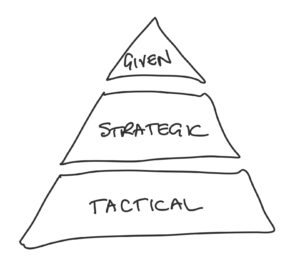One of the simplest tools in the opportunity framing toolkit is the Decision Hierarchy. It’s not just useful in developing a decision road map though, It is also a potential way out of those circular meeting discussions we’ve all been in. How often do we find ourselves down the rabbit hole of a topic that is hugely important to someone in the room but, in the bigger picture, doesn’t seem that important at all.
A good way out is to frame the discussion in terms of the decisions to be taken and ask if this decision, or topic, falls into the category of being Given, Strategic or Tactical. There’s a hierarchy to these:

At the top of the hierarchy is Givens, or decisions that have in fact already been taken. If you can agree it’s a given there’s little point in discussing it further. Assumptions can be seen in a similar way – if you can agree an assumption as being a ground rule for the decision at hand, it can be treated as a given,
At the bottom of the hierarchy are Tactical decisions. These will often attract a lot of discussion in meetings, especially where there are individuals invested in them directly. In reality, though, that discussion is not contributing effectively to the real decision at hand. Tactical decisions are the ones that can de delegated out the room, either lower down the organisation or to some point in the future.
If you can exclude Givens and Tactical decisions, you’re left with what should be the meat of the discussion, the Strategic decisions. These are the only ones that really matter and where a high quality discussion, with diverse input from knowledgable attendees, can really improve decision quality.
A short brainstorming exercise is a good way to separate these out. Give everyone some Post-Its™ and ask them to quickly write down what they think the discussion is about. In front of a board or flip chart, group these into a decision set, and then ask these simple questions.
- Has this decision already been taken, or the topic already been discussed and agreed? If it has, it’s a Given or a working assumption.
- Can this decision be taken later, or is it better discussed later? If so, it’s Tactical and it goes at the bottom of the hierarchy, and can be pushed out the discussion for now.
What’s left should be the Strategic decisions or topics that merit your time in them meeting.
Key Message: Structuring you conversation around truly strategic decisions or topics, by consciously excluding givens, agreed assumptions and tactical elements, can dramatically improve the quality and time effectiveness of your discussions and ultimately Decision Quality.
